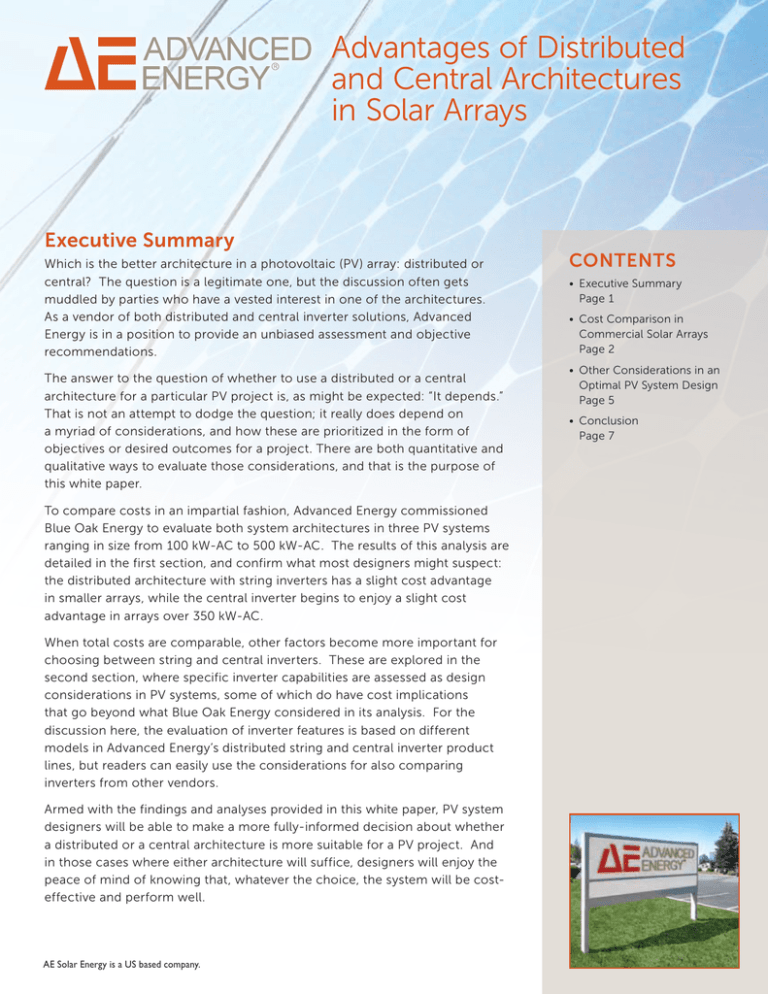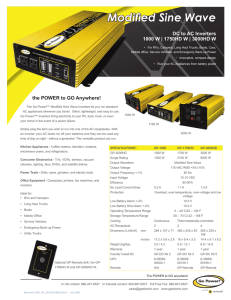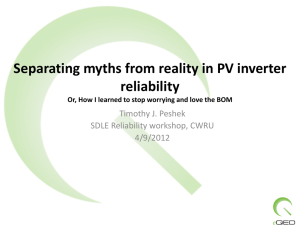
Advantages of Distributed
and Central Architectures
in Solar Arrays
Executive Summary
Which is the better architecture in a photovoltaic (PV) array: distributed or
central? The question is a legitimate one, but the discussion often gets
muddled by parties who have a vested interest in one of the architectures.
As a vendor of both distributed and central inverter solutions, Advanced
Energy is in a position to provide an unbiased assessment and objective
recommendations.
The answer to the question of whether to use a distributed or a central
architecture for a particular PV project is, as might be expected: “It depends.”
That is not an attempt to dodge the question; it really does depend on
a myriad of considerations, and how these are prioritized in the form of
objectives or desired outcomes for a project. There are both quantitative and
qualitative ways to evaluate those considerations, and that is the purpose of
this white paper.
To compare costs in an impartial fashion, Advanced Energy commissioned
Blue Oak Energy to evaluate both system architectures in three PV systems
ranging in size from 100 kW-AC to 500 kW-AC. The results of this analysis are
detailed in the first section, and confirm what most designers might suspect:
the distributed architecture with string inverters has a slight cost advantage
in smaller arrays, while the central inverter begins to enjoy a slight cost
advantage in arrays over 350 kW-AC.
When total costs are comparable, other factors become more important for
choosing between string and central inverters. These are explored in the
second section, where specific inverter capabilities are assessed as design
considerations in PV systems, some of which do have cost implications
that go beyond what Blue Oak Energy considered in its analysis. For the
discussion here, the evaluation of inverter features is based on different
models in Advanced Energy’s distributed string and central inverter product
lines, but readers can easily use the considerations for also comparing
inverters from other vendors.
Armed with the findings and analyses provided in this white paper, PV system
designers will be able to make a more fully-informed decision about whether
a distributed or a central architecture is more suitable for a PV project. And
in those cases where either architecture will suffice, designers will enjoy the
peace of mind of knowing that, whatever the choice, the system will be costeffective and perform well.
AE Solar Energy is a US based company.
CONTENTS
• Executive Summary
Page 1
• Cost Comparison in
Commercial Solar Arrays
Page 2
• Other Considerations in an
Optimal PV System Design
Page 5
•Conclusion
Page 7
White Paper
Cost Comparison in Commercial Solar Arrays
The choice between distributed and central PV system architectures is meaningful only for arrays where
it becomes possible to utilize more than one inverter. In other words, when a PV system has only a
single inverter, it uses by definition a “central” architecture. Conversely, the extreme case for distributed
architectures could be considered the use of a micro-inverter for each and every solar module.
To make for a valid architectural comparison, this analysis conducted by Blue Oak Energy established a
minimum array size of 100 kW-AC and a minimum string inverter size of 20 kW-AC for the distributed
architecture.
To evaluate the effect of scale on distributed and central architectures, three different application scenarios
were used in the comparison: 100 kW-AC, 260 kW-AC, and 500 kW-AC. To make the comparison
representative of “real-world” conditions, the study picked Newark, New Jersey as a location offering a
realistic temperature profile. Sixty percent of the modules were south-facing at a 20° fixed tilt with rooftop
mounting for minimal obstructions and shading. The remaining 40 percent of the modules were west-facing
at a 5° fixed tilt with carport mounting to experience some partial shading. These conditions, as well as the
inverter and Balance of System (BoS) configurations used, are summarized in Figure 1.
Cent ral Architecture
Distributed Architecture
260 kW
500 kW
100 kW
260 kW
500 kW
Newark, NJ
40°±
34° C
-15° C
Roof: 180° (south)
Carport: 270° (west)
Roof: 20° (30% of modules)
Carport: 5° (40% of modules)
130% approx
336+224
868+574
1652+1106
330+220
880+550
1650+1100
1
1
1
5
13
25
3 (switches)
1
1
0
0
0
0
0
0
1
3
5
0
0
0
0
1
1
480 Y / 277 V
100 kW
Location
Site Latitude
Max Dry Bulb
Min Dry Bulb
Array Azimuth
Module Tilt
Inverter Overload
Number of Modules
Number of Inverters
Number of DC Recombiners
Number of AC Panelboards
Number of AC Switchboards
Interconnection Voltage
Figure 1 – Summary of conditions and inverter/BoS configurations used in this comparison performed by
Blue Oak Energy.
The cost comparison was performed by creating electrical and mechanical designs for all of the systems,
and then comparing the equipment, material and labor costs associated with each design. The results of the
analysis are summarized graphically in Figure 2. As might be expected, the smaller string inverters enjoyed a
slight advantage in total cost in the smaller arrays, with the distributed architecture being up to 5 percent less
expensive than the central architecture. By interpolating the findings, the cost advantage appears to change
around 350 kW-AC to the central inverter.
2
White Paper
Total Costs ($/W)
Central Inverters
String Inverters
0
100
200
300
400
500
600
System Size (kWAC)
Figure 2 – Total costs using distributed string and central inverters in 100 kW-AC, 260 kW-AC and 500 kW-AC systems.
To evaluate real-world energy production, the effect of voltage and current mismatch was included with the
introduction of inter-row shading on the rooftop array, and partial shading from trees on the carport array. A
constant module-mismatch factor and a soiling factor that varied over the course of a year were also included
in the simulations to make the energy production comparison as realistic as possible.
Again as might be expected, the distributed architecture, with its smaller strings or sub-arrays of modules,
enjoyed a slight advantage in energy production based primarily on having the maximum power point
tracking (MPPT) occur at what would be the combiner box level in the central architecture. While line losses
were similar in both architectures, they came from different sources, with the AC losses of the distributed
architecture being comparable to the DC losses of the central architecture. The distributed string inverter
efficiency losses were slightly lower, however, compared to those of the central inverter, at ~2 and ~4 percent,
respectively. The multiple array planes also gave the decentralized architecture a slight production advantage.
The combination of these factors yielded a 1.5 percent higher performance ratio for the string inverters in all
three scenarios.
It is worth noting that, in general, PV systems with multiple solar angles and/or partial shading benefit from
the use of string inverters in a distributed architecture. This remains the case independently of the system’s
total capacity, which can easily exceed 500 kW-AC in campus settings. This means that string inverters might
have a financial advantage in larger systems based on energy generation despite costing more than central
inverters. Systems with arrays in multiple locations might also have space or weight constraints that favor the
use string inverters which are much more compact and lighter than central inverters.
3
White Paper
4 rooftop and 12 carport 855kW DC PV system utilizing a distributed architecture design; installed at the
VF Outdoor Coalition Campus, Alameda, CA. Photo courtesy of Hawkeye Photography.
500 kW ground mount PV system utilizing a central architecture design; installed at the City of Greeley
Water Pollution Control Facility. Photo courtesy of the City of Greeley.
4
White Paper
Other Considerations in an Optimal PV System Design
In PV systems where the total costs and energy production are comparable between distributed and central
architectures, creating an optimal design requires a more detailed evaluation of the specific capabilities or
features of the inverter(s), as well as the site, any constraints, and the overall monetary goals of the project.
These considerations are assessed in this section, and because they are all necessarily product-specific, the
discussion is based on Advanced Energy’s TL series string, and TX and NX series central inverters.
Although these considerations are mostly qualitative, some can have a significant effect on the quantitative
economic analysis, and these are identified in Table 2 in the context of Levelized Cost of Energy. As shown,
the major differences are to be found in the Balance of System (BoS) and the warranty period, which have an
effect on the capital and operational expenditures, respectively. It is important to note that because the Blue
Oak Energy study considered only the initial costs, the effect of the warranty and repair costs on ongoing
operational and maintenance (O&M) expenditures could become an important consideration in the choice of
architecture.
LCOE Considerations
TL
TX
NX
Effeciency
4
4
4
Balance of System Benefit
No DC Combiner
4
Integrated Sub-combiner
4
Integrated Breaker
4
Combiner-level PV Tie for Long Home-runs
4
Revenue Meter
4
3P Monitoring
4
Inverter 1st Cost (Project Size)
< 350 kW
< 350 kW
< 350 kW
Reliability
4
4
4
On-Site Service
4
4
Remove and Replace
4
Standard Warranty (Years)
5
10
5
Extended Warranty (up to 20 Years)
4
4
4
Table 1 – These inverter considerations all have at least some effect on the total cost of a PV system, especially on the
BoS, as well as on the operational and maintenance costs.
5
White Paper
As indicated in Table 1, some peripheral considerations can have a profound impact on PV system
economics. Such considerations might include the availability and cost of an O&M agreement, or the desire
to minimize energy loss due to inverter failures. Or a plant designed to maximize the capacity factor with a
high DC:AC ratio would require an inverter capable of supporting these higher ratios.
There are also scenarios where costs can become secondary to an inverter’s ability to meet critical system
design requirements. For example, Advanced Energy’s central inverters operate at 60 Hz, so only the TL
series string inverters are suitable for a 50 Hz system. Or in a system that requires low voltage ride-through,
Advanced Energy supports LVRT only in the NX series inverters currently. These and other “feature factors”
are identified in Table 2 as general design considerations.
Design Considerations
TL
TX
NX
High DC/AC Ratio
4
4
4
Advanced UIC
LVRT
4
Expanded Trips
4
Voltage Control
600 V DC
4
4
4
1000 V DC
4
4
Multiple Angles or Shading
4
4
Architecture
4
4
Floating
Grounded
50 Hz
4
60 Hz
4
Ontario FIT Compliance
208 V AC
480 V AC
600 V AC
4
4
Wide MPPT
Medium Voltage Interconnect
4
4
Bipolar
4
4
4
4
4
4
4
4
4
Table 2 – These inverter considerations can become determinative factors in the design of some PV systems, and may
have an indirect effect on total costs or energy production.
6
White Paper
Conclusion
Which is the better architecture in a PV system? As shown here, the answer really is: “It depends.” The size
of the project might make a compelling economic case for either a distributed or a central architecture.
For systems below 350 kW-AC, a distributed architecture with string inverters normally incurs a lower capital
expenditure; above that size, central inverters are usually (but not always) more cost-effective. But in many
if not most situations, other factors will need to be considered to achieve an optimal system design.
So while project size does matter, it should not dominate the design. For a variety of reasons (or maybe only
a single one) a central inverter designed for large-scale applications could be the better choice in relatively
small commercial systems, while smaller, distributed string inverters could be optimal in some utility-scale
plants. It depends.
To learn more about PV system design considerations, as well as Advanced Energy’s TL series string, and
TX and NX series central inverters, please visit Advanced Energy on the Web at www.advanced-energy.com/
solarenergy, or contact an Advanced Energy sales representative at sales.support@aei.com or by calling
877-312-3832.
7
AE Solar Energy • 115 Nicholson Lane • San Jose, CA 95134
www.advanced-energy.com/solarenergy
877.312.3832 • sales.support@aei.com • invertersupport@aei.com
Please see www.advanced-energy.com for worldwide contact information.
Advanced Energy is a registered U.S. trademark of Advanced Energy Industries, Inc.
© Advanced Energy Industries, Inc.
All rights reserved. Printed in U.S.A.
ENG-String_Central_Architecture-270-01 7/13





